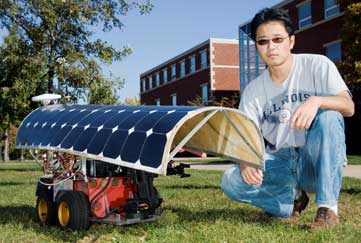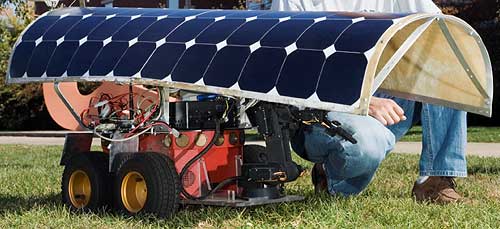Urbana, Illinois
October 10, 2006
A solar-powered robot with 20/20
vision, on a search-and-destroy quest for weeds, will soon be
moving up and down the crop rows at the experimental fields at
the University of Illinois (U
of I). What's more, this robot has the potential to control
weeds while significantly reducing herbicide use.
 The robot uses GPS for navigation, and there are two small
cameras mounted on a frame on top of the machine to give the
robot depth perception, just like a human, said Lei Tian,
agricultural engineer at the U of I. "If he sees a weed, he can
actually tell how far away it is." The robot uses GPS for navigation, and there are two small
cameras mounted on a frame on top of the machine to give the
robot depth perception, just like a human, said Lei Tian,
agricultural engineer at the U of I. "If he sees a weed, he can
actually tell how far away it is."
An on-board computer offers access to information that provides
the morphological features of plants, to help the robot
determine just what is and isn't a weed. Once a weed is
identified, a robotic arm attached to the front of the machine
engages a device the researcher calls "a custom-designed end
effector."
There are two layers to the device, according to Tian. One layer
cuts the weed, while the second layer applies herbicide to the
cut weed.
"This type of application is extremely effective," said Tian,
"because it applies herbicide directly to the plant, instead of
broadcasting uniform rates across a field."
With this level of precision, Tian says the system has clear
environmental benefits. In addition to cutting herbicide use,
chemicals do not drift off-target when placed directly on the
plants.
The original inspiration for this robot came several years ago,
when Tian and two graduate students were working on remote
sensing systems for a CFAR (Council on Food and Agricultural
Research) project.
"We were collecting field data from satellite imagery, such as
soil moisture and plant conditions, but we needed to have ground
reference data to validate that information," said Tian.
"But that kind of data is tedious to collect," he continued,
"and it's very hot work. The grad students who collected this
information stayed in the field most of the day, and one of them
was fainting from the heat."
 At the time, Tian was working on a robot that could go into the
field and continuously collect data, but the battery that
powered the system required charging about every two hours. At the time, Tian was working on a robot that could go into the
field and continuously collect data, but the battery that
powered the system required charging about every two hours.
"So I thought, what if we had a system that could collect data,
but could also convert the heat of the sun into an energy
source?" said Tian. "We could replace the grad student worker
with this robotic system."
That system evolved into today's model, and two different grad
students worked with Tian to present a paper on the robot at the
Annual International Meeting of Agricultural and Biological
Engineers this July in Portland, Oregon.
Hong Young Jeon, a PhD candidate in agricultural and biological
engineering, and Nathanael Gingrich, a master's student, have
worked steadily on the system design that cuts the weed and
applies herbicide. They have also mounted the curved solar panel
that powers the robot.
"We custom-built a shelf that holds the solar panel," said
Gingrich. "It also protects the machine from weather and gives
it shade for its vision system."
Although the robot is equipped with ultrasonic sensors that go
all the way around the machine, "we're going to try and use only
the camera vision for navigation," said Jeon, "which makes it a
lot more difficult."
The robot stands a little more than two feet tall, is 28 inches
wide and almost five feet long. He can travel about three miles
per hour and moves on wheels, although the researchers have
treads they can put on him as well, to give him more grip.
At the current stage, the robot is used to combat weed
infestation, but in the future, Gingrich and Jeon hope to place
different sensors and cameras on the robotic arm that would be
used to judge soil properties or plant conditions.
"It has a full-blown Windows computer with an 80-gigabyte hard
drive and a wireless connection to the Internet," said Gingrich,
"so the amount of information we can collect is virtually
unlimited."
Author: Leanne Lucas |